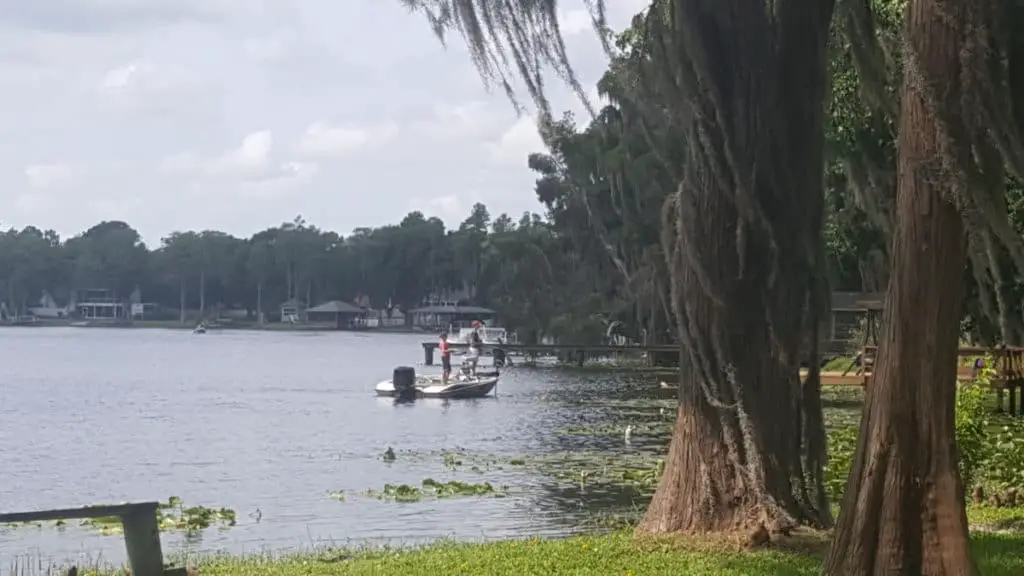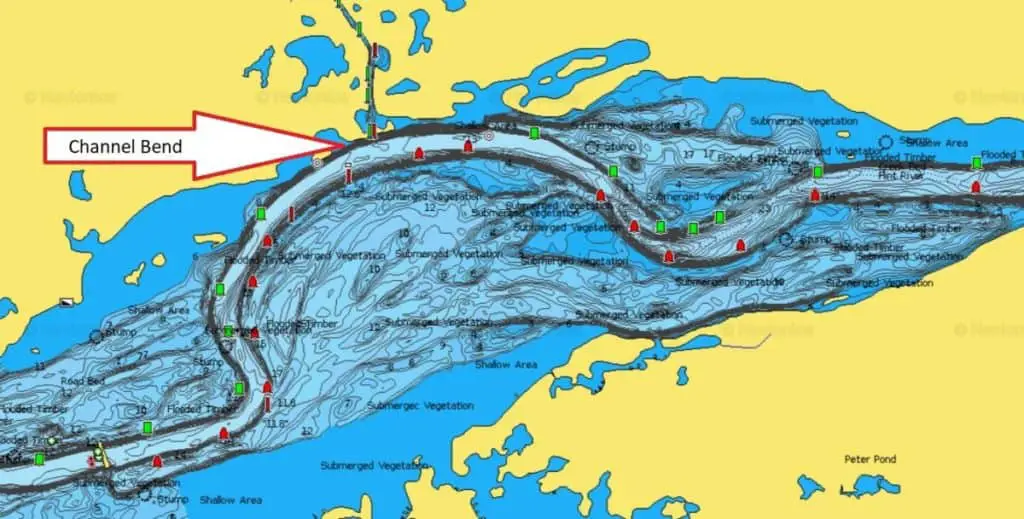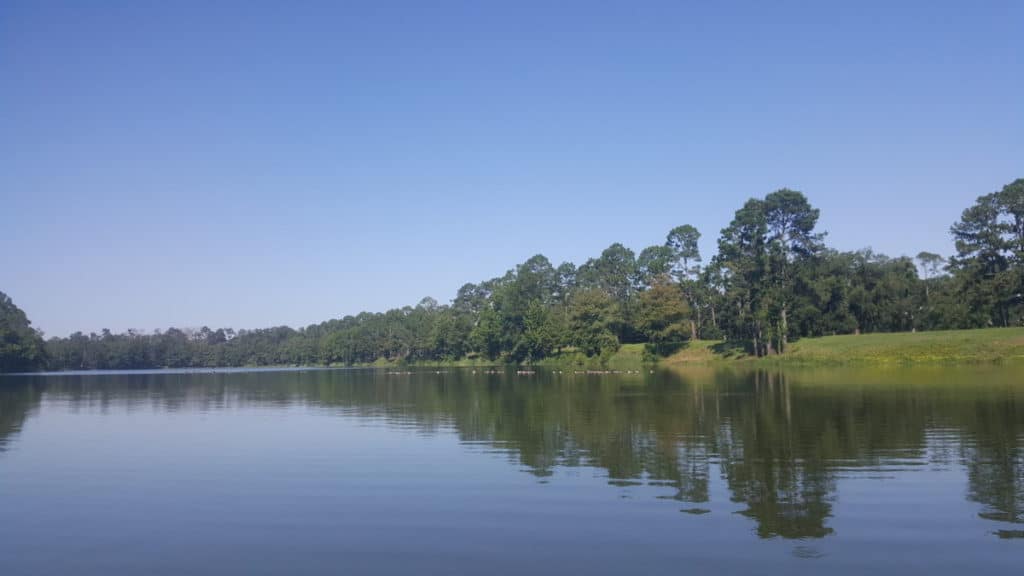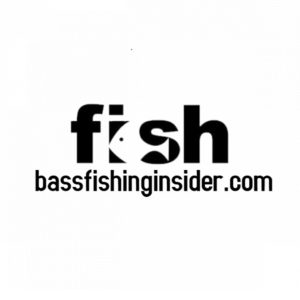
Fishing a new body of water can be both exciting and debilitating. Without any past experience, many questions arise about where to find bass, what lures are best to fish a new lake for bass, what tactics are for finding largemouth bass, and more.
When trying to figure out how to find largemouth bass, focus on gaining an understanding of the following nine key concepts to help you catch bass in a new lake:
Tip # 1 Use Structure and Cover to Find Bass on a New Lake
Bass look for structure or cover to set up a place to station themselves while waiting to ambush prey. How are structure and cover different?
Cover is something that bass use to wait on prey. Cover can include things like grass, pads, pilings, laydowns, weeds, and man-made fish attractors. Structure is related to the overall features of a body of water, such as the underwater changes in elevation, like ditches, ledges, and points.
The following are some of the best holding areas for bass:
- Channel Bend
Finding a place where the river’s main channel turns and edges near the shoreline can prove to be a reliable spot for finding bass. Visible evidence of these areas can often be seen in the form of high-wall bluffs. Again, Navionics and Lakemaster or another topographic map can be used during research to help identify these areas. Bass like to sit in these bends because they provide easy access to shallow and deep water and are a great ambush point for the bass looking for a meal.

- Riprap
Riprap is man-made cover produced when rocks or similar materials are placed on a shoreline to protect against erosion. Riprap can serve as a bass buffet providing a habitat perfect for much of the prey that bass seek, including bluegills, minnows, crawfish, and other baitfish. Riprap can be fished with a variety of lures and baits, including wacky rigs, shaky heads, and crankbaits, to name a few.
- Docks
Docks are one of the most consistent and reliable areas that hold fish year-round and can be a fast way to identify where bass live on lakes. They provide an obvious source of shade and cover that attracts baitfish and bass and are a perfect spot to start when fishing a new lake.
Insider Tip
As you approach a dock, start by fishing the edges of docks, the pilings, dock ladders, the canopy, or other outside edges of the dock. After you have fished those areas, THEN move to the inside of the dock by flipping or skipping your bait to harder-to-reach spots further under the dock.
By starting with the outside and working to the inside, you have a better chance of not spooking inside bass if you catch an outside edge bass first. This strategic move could pay off with multiple fish catches off one dock.
Wacky rigs, a Texas rig, and a drop shot are all good options for fishing the outside edges, along with various topwater lures like a popper or prop bait. Poppers and prop baits produce enough commotion that they may “pull” fish out of cover as a result of a bass’ curiosity or hunger.
The inside of a dock can be fished by skipping a larger profile bait like a jig (on a baitcaster). I love skipping smaller profile baits under docks as well, but this tactic is best with a spinning rod and reel to avoid backlashing with a baitcaaster while casting a lighter bait.
- Points
If you’re trying to figure out where to catch bass, one of the most well-known patterns for catching bass in a lake is to identify points on a lake to fish because they are excellent holding areas for bass.
According to Chattanoogan.com, a point is
“a location where the bottom is shallower than the surrounding area. These are usually triangular spots on the bottom formed by sediment carried by creeks or the current. They may extend a short distance or hundreds of yards into a lake.”
Crankbaits, spinnerbaits, and other moving baits are a great way to cover a ton of water efficiently as you work over large sections of points.
If you have a good fishfinder, you may be able to find brush piles on points. If so, slow down and fish them with a jig, texas rig, or other slower presentation, as brush piles on points are fish attractors. Topwater can also be productive over these piles.
- Isolated Cover
Bass are natural predators. Predators do best when they have a place to hide and wait for their next meal. Therefore, one of the first places I look for bass in a new lake is some form of cover. Bass naturally relate to things like laydowns, boulders, and other isolated pieces of cover where they wait, ready to ambush prey.
- Weeds and Grass
Vegetation is, perhaps, my favorite form of cover to fish.
Find the Grass = Find the Bass is a common mantra in my boat.
Vegetation like reeds, hydrilla, hyacinths, dollar pads, and more almost ALWAYS hold bass. When looking for one of the most reliable ways to find out where bass live in lakes, look for vegetation.
INSIDER TIP
Healthy vegetation also helps to filter water and keep the water cleaner, and BASS LOVE CLEAN WATER. In fact, in Florida and many southern locales, clean water is one of the very first things to look for when trying to find bass.
By healthy, I mean grass and weeds that are green. Brown (dying or dormant) grass is usually not a great sign. Look for the brightest, healthiest-looking vegetation in the lake for the best results.
Vegetation can be fished with a wide variety of baits and lures. For submerged grass, try throwing a chatterbait or rattle trap and ripping it through the grass to elicit bites. Slow-moving soft plastics also work well. For matted vegetation, punchbaits are the go-to bait. Swimjigs are effective in pads because they can be fished without much risk of getting stuck. Finally, flip reeds for bass in high percentage areas.
Check out Bass Fishing Insider’s article on fishing for bass in the reeds for great information on fishing reeds, a common piece of vegetation.
- Underwater humps
Bass like to hold near underwater deviations — anything different from the rest of the surroundings. Humps can be a great spot to find bass hunkered down while waiting to feed. You can fish underwater humps slowly with a tactic like drop-shotting or with a moving bait like a deep-diving crankbait.
- Wood
If you’re looking for a place where bass live, look for wood. Bass love natural cover, and wood is one of their favorites. Standing timber, log laydowns, and stumps are perfect spots for bass to lie in and wait as they look for an opportunity to grab baitfish or other prey that swim by.
Fish the wood with a moving bait like a squarebill (built to bounce or deflect off wood) or a slower bait like a jig or Texas-rigged worm. The tighter that you can fish to the cover, the better.
Tip #2 Water Temperature Affects Where Bass Are Located
Insider Tip
When faced with a body of water that is either very hot or very cold, look for water in the lake that is different than the rest. For example, in a very cold lake, look for areas in a lake that are a little warmer than others. Bass may move into those areas to escape the cold weather.
I remember being on Lake Seminole for a Bass Nation tournament when it was extremely cold. The lake was experiencing lower-than-normal temperatures.
Our strategy specifically revolved around finding warmer water. We looked for shallow water that would warm up faster than the rest of the lake. Even if the water in an area is warmer by just a couple of degrees, bass can react favorably to the difference.
Water temperature should be considered when trying to understand how to find bass fishing spots. Although many nuances are involved when considering water temperature, generally speaking, bass feed a little more aggressively in warmer water, so bigger, faster-moving baits may be in order (except for extreme heat where slow baits may prevail). Colder water means bass are more lethargic as a result of lower metabolism, so tactics that use a slower presentation make more sense.
Tip #3 Understand the impact of Wind on Bass Fishing Spots
Wind can undoubtedly be a friend or foe when bass fishing. Some people love it, others not so much.
Wind can stimulate bass, fire them up, and push fish higher in the water column and toward the surface. When windy, work baits with a “louder” presentation that attracts more attention, like a chatterbait or walking bait. Finesse presentations are probably out the door in extremely windy conditions.
When fishing with soft plastics, remember you’ll need enough weight to keep your bait near your intended bottom targets. When it’s extra windy, add a little more weight than you would typically use to maintain the same bottom contact as usual.
Tip #4 Weather Directly Affects Where You Find Bass
Weather can have a micro effect on the lake you are fishing, meaning that you should seriously consider the weather at your target body of water. The weather on your specific day of fishing and the days leading up to your fishing day will directly impact fish location, feeding intensity, and more.
Cloudy overcast days typically mean that bass will not hold as tight to cover and will roam a bit more looking to eat, so fishing a moving bait just off of what would be a bass’ usual cover may work well. Crankbaits, spinnerbaits, and other moving baits fit the bill.
Conversely, cover is more important to bass on bright, sunny days, and they hold much tighter to their usual ambush spots. Therefore, targeting specific cover is a better strategy for these kinds of days. I like baits like punchbaits, a Texas-rigged worm, and a speed worm or other bait that can be fished close to cover without getting stuck.
Tip #5 Research and Technology Are Tools for Locating Bass
Technology has come a long way over the last few years and is essential for breaking down a new lake. If you have electronics available, put them to good use to survey the lake, looking for underwater holding areas where bass may congregate.
I like to start at home to narrow down my options before heading to the lake, where I use my electronics to narrow things down to find specific spots to fish for bass. Here are a few of my favorite tools:
There’s google earth and google earth pro. They are quite different. Google earth pro must be downloaded to your computer.
I opt for google earth pro for some specific reasons. The most significant advantage to pro is that you can go back in history to see lake transformations over time which allows you to identify underwater structure or cover that may not be visible on the most current edition of live google earth. For example, you may find old roadbeds, sunken boats, grass beds, and other underwater features present year after year.
- Navionics and Lakemaster
Navionics and Lakemaster are powerful tools for finding bass fishing spots and can show topographical areas that make sense. Ledges, ditches, creek bends, points, and more are all great structures that can be identified by using Navionics.
Do your homework. Much of “fishing” can be done before making your first cast. Your work at home is as important as your work on the lake when you are looking for identifiable patterns for finding bass.
Tip #6 Use Seasonal Patterns to Find Bass
Seasonal patterns are an integral part of planning for a bass fishing trip.
Winter Bass Fishing Spots
Bass tend to head for deeper water on the main lake or main body of water when the water turns cold. Therefore, targeting underwater STRUCTURE where bass live during this time of year is essential. Because bass have a slower metabolism, they are not as aggressive, so it’s best to slow down your presentation, and you’ll often need to downsize your bait.
Finesse baits are a great play during the colder months. Vertical fishing right over the tops of fish with a drop shot can be effective. Working a jerkbait with extra-long pauses or slow rolling a crankbait are also good tactics.
For a detailed and thorough article that provides a specific plan for winter fishing, check out Bass Fishing Insider’s article, How Do you Catch Bass in the Winter (A Complete Guide).
How Do You Locate Bass in the Spring
As spring approaches, so does the time for bass to spawn. Of course, warmer climates like Florida experience a much longer period of spawning that can extend into larger parts of the year, but most parts of the country see a majority of their bass hit the beds in the spring.
Just before the spawn, the pre-spawn period occurs. Bass start their move from deep water to their spawning homes. Look for bass to move from deeper areas to shallow ones. The key is to find a structural piece that serves as a transition. For example, if you usually fish a long underwater ditch out deep, now, it’s time to fish the part of the ditch closest to a spawning flat. Fish these structures with a rattle trap, slow-moving jigs, or a jerkbait worked a little faster than you would in the wintertime.
When the spawn starts, bass move to the shallow areas of lakes, looking for the best hard bottom areas they can find to make beds. The backs of creeks, coves, flats, and any other shallow water spot in the lake are good spots to look for spawning bass. Wind-protected areas can be some of the best areas to check for bedding bass.
Although there are many tactics for catching bedding fish, soft plastics seem to rule, especially when you can visibly see the beds. Approach the beds with stealth and then work baits very slowly. Tempting a bedding fish to bite can take a very long time. I’ve spent up to 45 minutes on a fish in tournaments to entice them to bite (it was a large fish and worth it!).
When you can’t visibly see beds, try working a moving bait like a spinnerbait through likely spawning areas to grab the attention of bedding bass ( a la Rick Clunn in his 2019 St. Johns River Elite win).
Where Do Bass Go in the Summer and the Post-Spawn
Breaking down a new lake in the summer can be challenging because of the hot weather and warmer water. After the spawn and before summer, a post-spawn transition occurs. Many bass, fatigued after the spawn, will move off beds but not very far.
Look for cover and structure close to a spawning area but not too far away. Docks, secondary points, laydowns, and other cover are great places to start. Unfortunately, bass are sometimes not as interested in feeding post-spawn, so you may have to work reaction baits to get them to bite.
As summer approaches, hotter weather moves in, meaning warmer water. Warmer water means that the bass will be on the move back to their deepwater homes.
Time to once again check for structure related to deeper water. Check for offshore structure like creek channels, river and creek bends, channel drop-offs, and main lake points. Start with Navionics, Lakemaster, or another topographic tool to identify these areas.
Also, bass love to hang out in the shade of things like docks and overhanging trees, so spend time fishing shade and the shady side of the lake when possible.
The morning summer bite can be strong. Therefore, Topwater or faster-moving bites may be in order. However, once the sun is up and bass duck for cover, you’ll need to slow down and fish as tightly to cover as possible. Flipping or pitching a jig or Texas-rigged worm to specific cover targets is the way to go.
Fall Bass Fishing Spots
When the Fall approaches, it’s time to look for baitfish as your primary means of locating fish. Look for baitfish and bass following “fish highways” back from their spawning flats to the main lake. Bass will use ditches, ledges, weedlines, and other avenues to move from bedding areas back to the main areas of the body of water. Fish these transition areas with deep diving crankbaits, jerkbaits that mimic baitfish in the lake or river, and topwaters like walking baits.
INSIDER TIP
Once you’ve arrived at the structure you intend to fish, if you have access to a fishfinder, pay attention for cover such as underwater rock piles, boulders, or brush piles. Finding structure combined with cover can be gold in terms of locating bass on a new lake.
Tip #7 To Find Bass, Cover water efficiently and quickly.
Whether fishing a new lake or getting out to my favorite body of water after a long break, the sheer size and amount of water can seem overwhelming.
I like to fish smartly by covering a lot of water as efficiently as possible first to get a feeling of where the bass are and what they are doing. The fact of the matter is that bass are not located in every spot on a lake. To find bass on a new lake, understand that bass seek out common areas and follow certain location patterns.
Bass tend to gravitate to certain areas, and for good reasons. The notion that 90 percent of the fish are in 10 percent of the water can be very accurate.
Covering water quickly is critical. I like to use moving baits like crankbaits, bladed jigs, and spinnerbaits as search baits for bass.
AFTER I’ve located bass with a good search bait, I like to go back and SLOW down. To effectively fish where the big bass hide, jigs or another soft plastic are my favorites for fishing slower and dissecting an area I’ve found in my initial “cover water” strategy.
Tip #8 People are Allies in your Quest to Locate Bass

Information is key to helping you discover the best areas and tactics for finding bass on a new lake. So when I’m heading out to fish, I like to avail myself of all possible sources of info.
If I don’t know anyone who normally fishes a lake, I am not afraid to pick up the phone or jump online to network and find people familiar with where I intend to fish.
Places I like to look are:
- Bait and Tackle Stores: Call the closest bait and tackle store. Owners or staff are usually happy to provide information on where to catch bass. After all, they have a vested interest in people catching fish and doing well in their local fishery. Open-ended questions work best for gaining insight from a local. A store visit can pay off with info and even some specialized lures, tackle, or live bait most suitable for the area.
- Marinas and their staff see many boaters and fishermen who store boats at their facilities, visit their restaurants, or launch boats at their ramps. Inevitably, marina staff will have conversations with their patrons about their fishing successes on the water. Visit them or check in before launching at their site to ask about the latest info from the lake.
- Facebook Groups Facebook is made for sharing, and people love to share their fishing experiences in Facebook groups. (Groups are usually better than pages as most pages have business intent, whereas groups are more like online communities of people).
Go to Facebook, type in your target body of water or area of your state or country, and you’ll likely find a group dedicated to sharing details that may help you as you plan your next trip.
After joining the group, you can search the group for your particular lake, tactics, seasonal information, and more. Also, post a question asking where you can find bass in a specific body of water and wait for comments from the group.
- Internet Forums Like Facebook, internet forums are a place where people gather to share information. Topics usually start with questions in forums inviting people to chip in and answer. Then, browse or search the forum for answers, post your question, and gather responses. People are proud to share their knowledge, and the information they provide can be priceless.
Tip #9 Fish in the Moment to Locate Bass
While all of the above bass-locating techniques, tactics, and strategies are vital for your success on new water, letting your senses and experience guide you is equally important.
Do you notice baitfish running in a particular area? See birds diving on bait? Do you see visual cues that fish are in the area, like reeds or pads moving?
I’ve had many instances where I notice something like disturbed water that gives away the presence of a fish or notice a school near me giving away their deepwater cover hideout.
Additionally, I like to use my experience fishing another body of water that resembles my current situation and use tactics that worked previously in another lake to try to duplicate my success.
Using intuition, observation, and experience can be every bit as important as any of the other eight factors above.
Final Word
You can approach new water efficiently and wisely using these tips, tricks, and strategies. Use the key concepts above to help you narrow your search to make intelligent choices about where to fish for bass in new lakes rather than hitting the lake and casting blindly. Time to wet a line!
